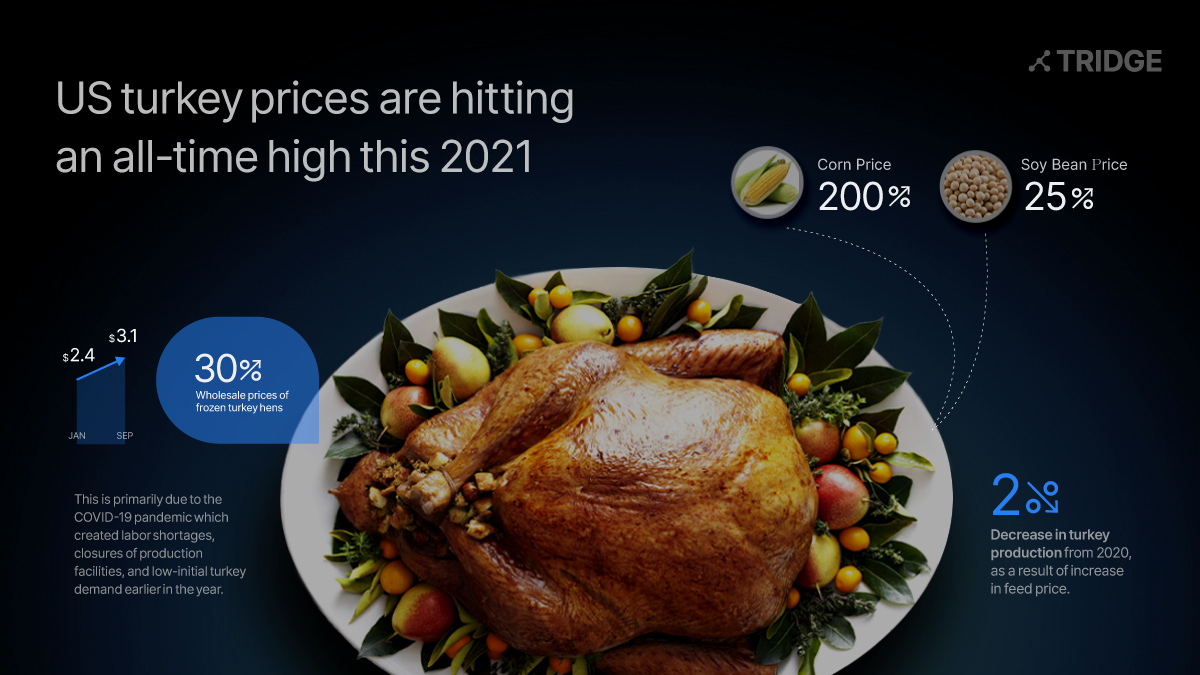US Thanksgiving celebrations expected to be expensive as turkey prices soar in 2021

Price rally in the US turkey market
US national turkey prices started their rally in January 2019. However, the biggest price spikes have been seen in 2021. In January-September wholesale monthly prices for frozen turkey hens climbed by 30% and averaged $3.12/kg in September 2021, exceeding the previous record high in October 2015 at $2.99/kg.
* October 2021 prices are as of 22 October 2021
Source: AMS USDA
The situation in the US turkey parts market looks similar. However, US national prices for turkey tom drumsticks have been increasing since mid-2020, with monthly average values reaching $2.60/kg at the end of October versus $1.41/kg in July 2020.
Unprecedented price jumps are attributed to various fundamental factors, the influence of which was supported by complications amid COVID closures.
Increase in production costs
National prices for soybean meal have been also increasing in the past two years, however, at a slower pace than corn values. From June 2020 to August 2021, US soybean meal prices elevated by 25%, with the biggest gains observed in November 2020-January 2021. Prices started to decline after May 2021 following the news about extending soybean acreage for the 2021 harvest. This has brought some relief for US turkey manufacturers.
The impending COVID-19 pandemic only aggravated the situation. USDA has already revised down turkey meat output forecasts a few times this year. According to the USDA’s October report, turkey production in the USA is forecast at 2.54 million tons in 2021, which is 2% lower than in the previous year. This is also 4,500 tons less compared to September’s estimate.
COVID-19 has been adding complications to the US turkey industry for the past two years. Labor shortages in the poultry sector had started way before the pandemic. The looming epidemic deepened the problem. Increasing numbers of COVID-19 cases have caused numerous lockdowns across the country, which resulted in the closure of farms, processing plants, and lack of labor force. The agricultural sector, especially meat production, cannot function without workers on the production site. It is a labor-intensive sector, which requires repetitive actions as well as physical strength.
At the beginning of 2020, when the pandemic was in the early development stage, massive lockdowns brought sudden shocks to the country’s population, bringing down the demand for turkey meat. To avoid losses, some companies had to dismiss the working force. Another issue was that during the pandemic people were forced to stay at home, which, as a result, disrupted the whole production cycle. Consequently, slaughter rates have slowed down and overall US turkey meat supply has declined. The USDA’s figures of turkey meat in cold storage also confirm the limited supplies on the market. As of 30 September 2021, US cold storage stocks of turkey fell below 188,000 tons, representing a 17% decline year on year.
Sources:
TURKEY MARKET NEWS REPORT
Livestock, Dairy, and Poultry Outlook: October 2021
TURKEY: Weekly National Fresh and Frozen Whole Young Turkeys (Fri)
Turkey production declines for third consecutive year
High feed costs lead to lower turkey profitability
Grain: World Markets and Trade
Virginiabusiness.com
World Agricultural Supply and Demand Estimates
Another Look at Availability and Prices of Food Amid the COVID-19 Pandemic


